The Sleeper Pads Market is estimated to be valued at USD 121.2 billion in 2025 and is projected to reach USD 240.6 billion by 2035, registering a compound annual growth rate (CAGR) of 7.1% over the forecast period.
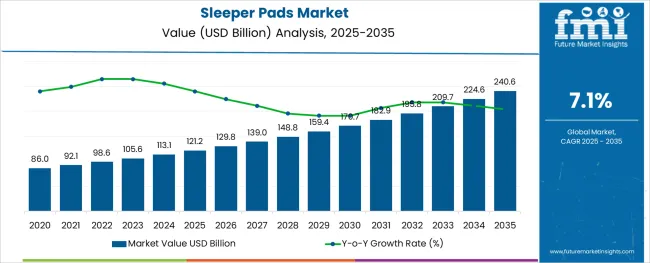
The sleeper pads market is experiencing steady growth due to increasing consumer demand for enhanced sleep comfort and ergonomic support. Industry insights highlight rising awareness about the health benefits of quality sleep and the role of sleep accessories in improving rest quality. Growing adoption of memory foam technology has transformed the mattress and bedding segment by offering superior pressure relief and body contouring.
Expanding residential construction and home renovation activities have contributed to increased sales of sleep-related products. Furthermore, lifestyle shifts towards prioritizing wellness and self-care have encouraged consumers to invest in premium sleep products.
The market is also being driven by innovations in material technology and the expansion of online retail channels, enhancing product accessibility. Segmental growth is expected to be led by memory foam as the preferred material, mattress applications, and residential end-users who seek comfort and durability.
The market is segmented by Material, Application, and End-User and region. By Material, the market is divided into Memory Foam, Latex, Polyester, and Other Materials. In terms of Application, the market is classified into Mattress, Pillows, Bed Toppers, and Other Applications.
Based on End-User, the market is segmented into Residential, Hotels, Hospitals, and Other End Users. Regionally, the market is classified into North America, Latin America, Western Europe, Eastern Europe, Balkan & Baltic Countries, Russia & Belarus, Central Asia, East Asia, South Asia & Pacific, and the Middle East & Africa.
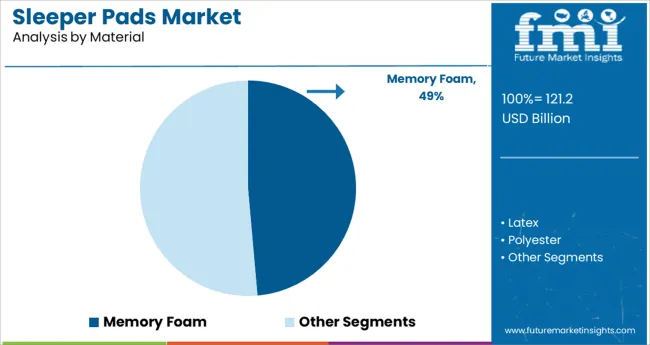
The memory foam segment is expected to account for 48.6% of the sleeper pads market revenue in 2025, maintaining its position as the leading material type. The segment’s growth has been driven by memory foam’s unique ability to provide pressure relief and adapt to body contours, offering superior comfort compared to traditional materials.
Consumers have increasingly preferred memory foam for its durability and hypoallergenic properties, making it suitable for sensitive sleepers. Product advancements have improved foam breathability and cooling features, addressing past concerns about heat retention.
The widespread availability of memory foam pads in various thicknesses and firmness levels has expanded its appeal across different consumer preferences. As awareness of sleep quality continues to rise, memory foam is expected to remain the dominant material choice in the sleeper pads market.
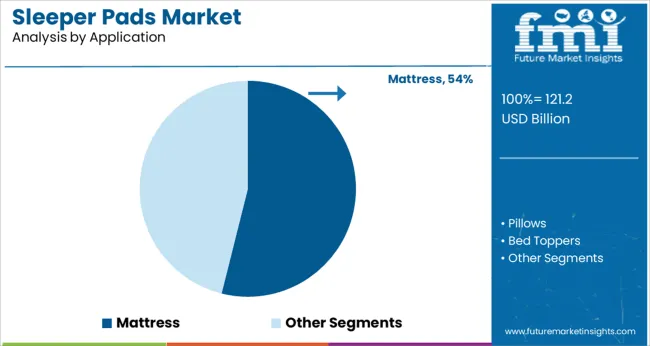
The mattress application segment is projected to contribute 53.9% of the market revenue in 2025, holding the largest share among applications. This growth is supported by the integration of sleeper pads as essential components to enhance mattress comfort and lifespan.
Consumers have increasingly used pads to customize firmness, improve hygiene, and protect mattresses from wear and stains. The rise of direct-to-consumer mattress brands and the expansion of online sales channels have made mattress-related accessories more accessible.
Additionally, mattress pads featuring memory foam and other advanced materials have gained popularity as affordable upgrades compared to purchasing new mattresses. The mattress segment’s prominence is expected to continue as consumers seek practical and cost-effective sleep solutions.
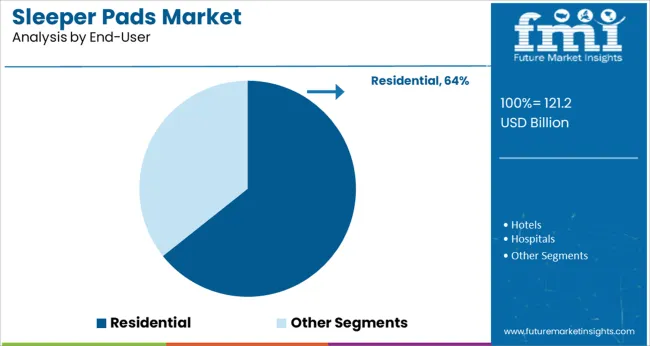
The residential segment is anticipated to hold 64.3% of the sleeper pads market revenue in 2025, establishing it as the largest end-user category. This dominance is attributed to increasing consumer focus on home comfort and the growing trend of upgrading bedding essentials.
Homeowners and renters alike have invested in sleeper pads to enhance sleep quality, particularly as awareness of ergonomics and health benefits has increased. The residential market has benefited from widespread online retail penetration, enabling consumers to access a diverse range of products.
Additionally, rising disposable incomes and the growth of urban housing developments have supported increased demand. As sleep wellness remains a priority, the residential segment is expected to sustain its leading role in the sleeper pads market.
To muster the needs of better transport infrastructure and urbanization, advanced transportation systems are being developed across the world. This has instilled the use of high-speed railways. However, high-speed railway cars can cause substantial vibrations, which can reduce ride quality and cause adverse stability.
Furthermore, technological advancements in railways concerning power enhancement and speed require effective vibration reaction and efficient suspension. Owing to the ability of sleeper pads to avail suspension even at high speed and high load conditions, the demand for sleeper pads is projected to witness substantial growth all across the globe.
The government authorities of various countries are pivoting on strengthening their networks by investing in expanding railway networks in order to meet transportation demand. This is estimated to impact the sleeper pads market positively over the forecast timeline.
The freight-based rail locomotives are subject to mechanical stress due to heavy loads hence require installation and periodic replacement of sleeper pads.
Owing to periodic replacement and retrofitting of existing grids in the rail networks, the aftermarket sales channel of sleeper pads is estimated to project significant opportunities in the global sleeper pads market. Attributing to this, the sales of sleeper pads are expected to witness healthy growth during the forecast period.
Whereas, there are some factors curtailing the growth rate in the global sleeper pads market such as high installation cost and difficulty for installations in existing grids. However, the current trend for deployment of better technology for improvement in results will contribute towards the growth of global sleeper pads market over the forecast period.
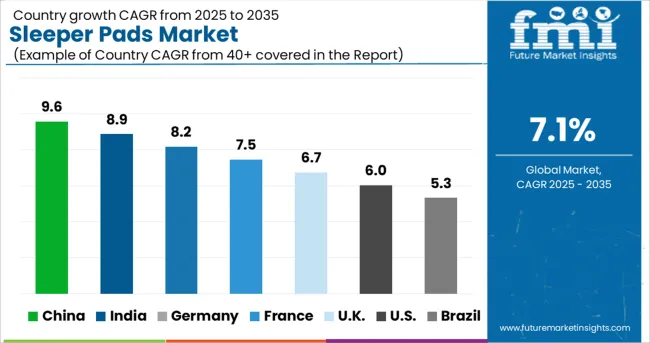
Rapid developments in the rolling stock industry have prompted a wave of strategic flourishing in the global sleeper pad market over the coming years. In the emerging economies such as China, government are focused to sprawling railway network for high-speed trains is aid to boom the sales of sleeper pads over the coming decades.
Western Europe and North America are expected to dominate the sleeper pads market owing to these regions are projected to account for a leading share in the global rolling stock industry. Furthermore, the introduction of new projects in these regions is also expected to increase the demand for sleeper pads in the coming years.
Asia pacific region is projected to create lucrative growth in the sleeper pads market, owing to rising railway passenger density over the span of coming years. The Middle East & Africa is estimated to account for a relatively smaller share in the global sleeper pads market owing to inadequacy in the production of railway components over the forecast period.
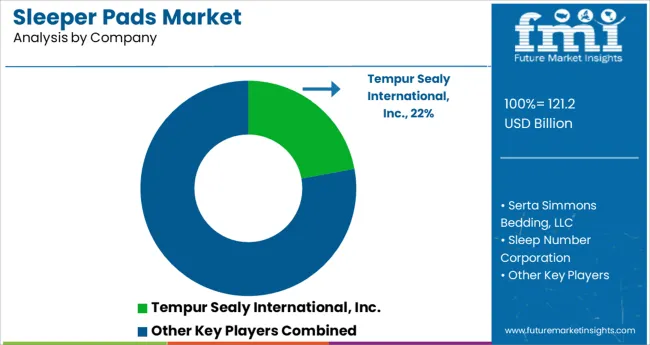
The key players of the sleeper pads market are focusing on enhancing and adopting strategies like enhancing the durability, sizes and its use to thrive business. This is driving down the sales of sleeper pads.
Some of the key participating players indulged in the sales of sleeper pads are:
These market players are anticipated to drive the sleeper pads market by introducing new products and expanding geographically.
This section includes a holistic view of the competitive landscape that includes various strategic developments such as key mergers & acquisitions, future capacities, partnerships, financial overviews, collaborations, new product developments, new product launches, and other developments.
| Report Attribute | Details |
|---|---|
| Growth Rate | CAGR of 7.1% from 2025 to 2035 |
| Base year for estimation | 2025 |
| Historical data | 2020 to 2024 |
| Forecast period | 2025 to 2035 |
| Quantitative units | Revenue in billion, volume in kilotons, and CAGR from 2025 to 2035 |
| Report coverage | Revenue forecast, volume forecast, company ranking, competitive landscape, growth factors, and trends, Pricing Analysis |
| Segments covered | Product type, Application, Region |
| Regional scope | North America; Latin America; Western Europe; Eastern Europe; Japan; Asia Pacific; Middle East and Africa (MEA) |
| Country scope | USA, Canada, Mexico, Brazil, Germany, Italy, France, UK, Spain, Poland, Russia, China, India, ASEAN, Australia & New Zealand, Japan, GCC Countries, S. Africa, Northern Africa |
| Key companies profiled | Sea to Summit; Therm-a-Rest; REI; KLYMIT; Nemo Equipment; Exped; Decathlon; Outdoor gear lab; Mammut; Alpinizmo; Getzner |
| Customization scope | Free report customization (equivalent to up to 8 analysts working days) with purchase. Addition or alteration to country, regional & segment scope. |
| Pricing and purchase options | Avail customized purchase options to meet your exact research needs. |
The global sleeper pads market is estimated to be valued at USD 121.2 billion in 2025.
It is projected to reach USD 240.6 billion by 2035.
The market is expected to grow at a 7.1% CAGR between 2025 and 2035.
The key product types are memory foam, latex, polyester and other materials.
mattress segment is expected to dominate with a 53.9% industry share in 2025.






Our Research Products

The "Full Research Suite" delivers actionable market intel, deep dives on markets or technologies, so clients act faster, cut risk, and unlock growth.

The Leaderboard benchmarks and ranks top vendors, classifying them as Established Leaders, Leading Challengers, or Disruptors & Challengers.

Locates where complements amplify value and substitutes erode it, forecasting net impact by horizon

We deliver granular, decision-grade intel: market sizing, 5-year forecasts, pricing, adoption, usage, revenue, and operational KPIs—plus competitor tracking, regulation, and value chains—across 60 countries broadly.

Spot the shifts before they hit your P&L. We track inflection points, adoption curves, pricing moves, and ecosystem plays to show where demand is heading, why it is changing, and what to do next across high-growth markets and disruptive tech

Real-time reads of user behavior. We track shifting priorities, perceptions of today’s and next-gen services, and provider experience, then pace how fast tech moves from trial to adoption, blending buyer, consumer, and channel inputs with social signals (#WhySwitch, #UX).

Partner with our analyst team to build a custom report designed around your business priorities. From analysing market trends to assessing competitors or crafting bespoke datasets, we tailor insights to your needs.
Supplier Intelligence
Discovery & Profiling
Capacity & Footprint
Performance & Risk
Compliance & Governance
Commercial Readiness
Who Supplies Whom
Scorecards & Shortlists
Playbooks & Docs
Category Intelligence
Definition & Scope
Demand & Use Cases
Cost Drivers
Market Structure
Supply Chain Map
Trade & Policy
Operating Norms
Deliverables
Buyer Intelligence
Account Basics
Spend & Scope
Procurement Model
Vendor Requirements
Terms & Policies
Entry Strategy
Pain Points & Triggers
Outputs
Pricing Analysis
Benchmarks
Trends
Should-Cost
Indexation
Landed Cost
Commercial Terms
Deliverables
Brand Analysis
Positioning & Value Prop
Share & Presence
Customer Evidence
Go-to-Market
Digital & Reputation
Compliance & Trust
KPIs & Gaps
Outputs
Full Research Suite comprises of:
Market outlook & trends analysis
Interviews & case studies
Strategic recommendations
Vendor profiles & capabilities analysis
5-year forecasts
8 regions and 60+ country-level data splits
Market segment data splits
12 months of continuous data updates
DELIVERED AS:
PDF EXCEL ONLINE
Baby Portable Co-Sleeper Market
Examining Market Share Trends in the Meat Pads Industry
Brake Pads and Shoes Market Size and Share Forecast Outlook 2025 to 2035
Global Toner Pads Market Size and Share Forecast Outlook 2025 to 2035
Layer Pads Market from 2025 to 2035
Corner Pads Market Insights - Growth & Demand 2025 to 2035
Tipper Pads Market
Scouring Pads Market Size and Share Forecast Outlook 2025 to 2035
Mattress Pads Market Analysis - Size, Share, and Forecast Outlook 2025 to 2035
Exfoliating Pads Market Analysis - Size and Share Forecast Outlook 2025 to 2035
Die Cut Support Pads Market Size and Share Forecast Outlook 2025 to 2035
Heated Mattress Pads Market
Reusable Nursing Pads Market Size and Share Forecast Outlook 2025 to 2035
Reusable Sanitary Pads Market Growth - Size, Demand & Forecast 2025 to 2035
Thermal Interface Pads and Materials Market Growth - Trends, Analysis & Forecast by Type, product, Application and Region through 2035
Chemical Absorbent Pads Market Size and Share Forecast Outlook 2025 to 2035
Pressure Redistribution Pads Market
Automotive Sintered Brake Pads Market Size and Share Forecast Outlook 2025 to 2035
Automotive Energy Absorption (EA) Pads Market Size and Share Forecast Outlook 2025 to 2035

Thank you!
You will receive an email from our Business Development Manager. Please be sure to check your SPAM/JUNK folder too.
Chat With
MaRIA